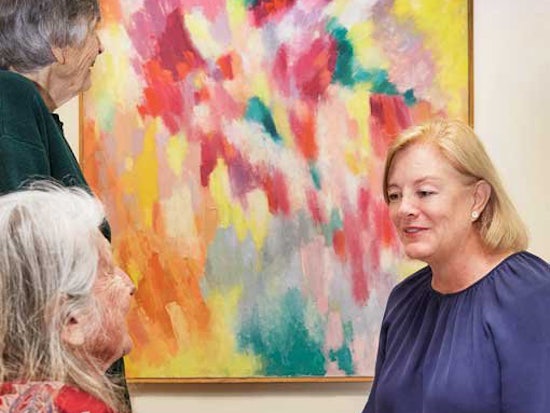Art brings ‘in the moment’ pleasure for those living with dementia
A study into the Art Gallery of New South Wales’s (AGNSW) Arts Access program for people living with dementia highlights the pleasurable experience that looking at art brings for people with dementia as well as their carers, family members and health care professionals.

The program was inspired by a similar arts access program for people with dementia set up by The Museum of Modern Art (MOMA) in New York ten years ago. Recognising the beneficial impact of engaging with artworks at MOMA, the AGNSW ran a pilot program inviting people living with dementia to view iconic works in the gallery collection.
Now each month a group of people living with dementia visit the gallery and view artworks with specially trained guides who have an in-depth knowledge of the artworks.
“Participants have an opportunity for meaningful and interactive engagement with art and are invited to imagine and think creatively in a safe environment,” explains Danielle Gullotta, AGNSW access program coordinator. “Guides encourage self-expression where participants’ curiosity is stimulated through focused observation, group discussion and personal connections.”
The study into the program, entitled Arts Engagement for People with Dementia, was headed up by Dr Gail Kenning PhD, University of Technology, Sydney. Dr Kenning says the study involved both qualitative and quantitative research.
Artworks selected for the study include iconic Australian masterpieces, works from international touring exhibitions, award-winning works from annual exhibitions such as the Archibald, Wynne and Sulman Prizes and AGNSW collection ‘audience favourites’ such as Elioth Gruner’s Spring frost (1919).
“While dementia impacts cognitive and physical functioning and memory, consciousness and emotions remain intact. This means people living with dementia show affective responses and can experience the pleasure of looking at and talking about art,” says Dr Kenning.
Participants laughed, smiled, and pointed at things they noticed in the paintings. Others reminisced about their experiences of growing up in the Australian bushland, or made associations from the paintings to events in their daily lives.
As a small group viewed Herbert Badham’s Breakfast piece, they reminisced about times when they would formally set the table for lunch with a table cloth and napkins. Other participants noted the painting has been made at the beginning of WWII.
The trained program facilitators, in turn, spoke of their joy in seeing people come quietly into the gallery and then suddenly “open-up and start talking”.
Dr Kenning highlights the study did not focus on memory, and whether people living with dementia remembered their engagement with art, but recognised the positive impact of ‘in the moment’ pleasure of experiencing art and of feeling valued, supported, acknowledged, and challenged.
The findings are supported by Alzheimer’s Australia NSW as they provide a valuable evidence-base for the outcomes of such programming.
The evaluation model used in the AGNSW study will contribute to a growing body of research that focuses on the extent to which the lives of people living with dementia can be enriched through the stimulation that engaging with the visual arts can provide, and will help inform wider implementation of inclusive programs for people living with dementia.
Recent research has indicated that social isolation and loneliness are the most significant issues people face once diagnosed with dementia.











![The new Aged Care Act exposure draft is slated for release in December of 2023, but advocates hope to see it rolled out on January 1, 2024. [Source: Shutterstock]](https://agedcareguide-assets.imgix.net/news/articles/wp/agedcareact__0811.jpg?fm=pjpg&w=520&format=auto&q=65)












Comments